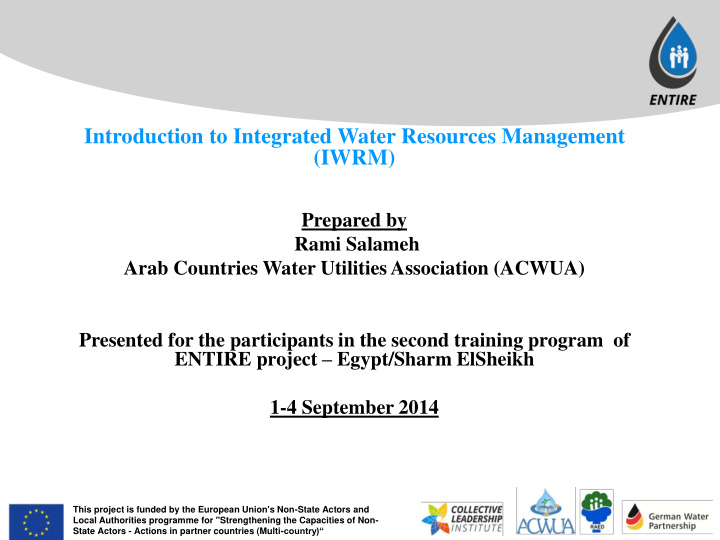



Introduction to Integrated Water Resources Management (IWRM) Prepared by Rami Salameh Arab Countries Water Utilities Association (ACWUA) Presented for the participants in the second training program of ENTIRE project – Egypt/Sharm ElSheikh 1-4 September 2014 This project is funded by the European Union's Non-State Actors and Local Authorities programme for "Strengthening the Capacities of Non- State Actors - Actions in partner countries (Multi- country)“
WATER PROBLEMS ??!! Population growth demands for more water, producing more WW Urbanization migration from rural to urban areas Economic growth increased demand for economic activities Globalization of trade production is relocated to “labor - cheap” areas that takes place without consideration for water resources Climate change increase uncertainty about water cycle, more intense floods and droughts ….. ….. This project is funded by the European Union's Non-State Actors and Local Authorities programme for "Strengthening the Capacities of Non- State Actors - Actions in partner countries (Multi- country)“
THE CONCEPT OF IWRM…. • The basis of IWRM is that different uses of water are An Empirical Concept which is interdependent built up from the experiences • Integrated management means that all different uses of water It is not a scientific theory that resources are considered together needs to be proved or disproved by scholars!! It requires stakeholders to make judgments about which reforms , measures , management tools and institutional arrangements are most appropriate for water management. This project is funded by the European Union's Non-State Actors and Local Authorities programme for "Strengthening the Capacities of Non- State Actors - Actions in partner countries (Multi- country)“
WHY IWRM? Globally accepted Incorporates social, environmental and economical considerations directly into policy and decision making. Support sustainability Directly involves the stakeholders Tool for climate change adaptation This project is funded by the European Union's Non-State Actors and Local Authorities programme for "Strengthening the Capacities of Non- State Actors - Actions in partner countries (Multi- country)“
IWRM DEFINITION IWRM is a process which promotes the coordinated development and management of water, land and related resources, in order to maximize the resultant economic and social welfare in an equitable manner without compromising the sustainability of vital ecosystems. GWP, 2000 This project is funded by the European Union's Non-State Actors and Local Authorities programme for "Strengthening the Capacities of Non- State Actors - Actions in partner countries (Multi- country)“
THREE PILLARS OF IWRM The “three pillars” of IWRM are; 1. Ecological Sustainability 2. Economic Efficiency 3. Social Equity What we need to achieve it? - Moving towards enabling environment of appropriate policies, strategies and legislation - Putting in place the institutional framework (through which policies can be implemented) - Setting up the management instruments required by these institutions to do their job This project is funded by the European Union's Non-State Actors and Local Authorities programme for "Strengthening the Capacities of Non- State Actors - Actions in partner countries (Multi- country)“
TRADITIONAL VS. INTEGRATED APPROACH…..WHAT IS DIFFERENT? • Traditional approach Integrated approach • One sector • Multi sectors • Limited institutions involved • Various institutions involved • Decision making at one • Collective decision making sector • Complex issues addressed • Specific issues addressed This project is funded by the European Union's Non-State Actors and Local Authorities programme for "Strengthening the Capacities of Non- State Actors - Actions in partner countries (Multi- country)“
WHAT IS STAKEHOLDERS’ DIALOGUE? Stakeholders’ dialogue is “ Process which aims to bring relevant stakeholders into contact with each other’s to discuss certain issue/problem and exchange information between the different actors to generate agreed solutions of problems” This project is funded by the European Union's Non-State Actors and Local Authorities programme for "Strengthening the Capacities of Non- State Actors - Actions in partner countries (Multi- country)“
WHY STAKEHOLDERS ’ DIALOGUE? Efficient participation of different actors in managing water resources has been defined as one of the sustainable water management principles. It promotes “Social Equity” which is one of the fundamental topics of IWRM. It facilitate generate equitable and sustainable solutions to water problems and promote “bottom – up” decision making process. This project is funded by the European Union's Non-State Actors and Local Authorities programme for "Strengthening the Capacities of Non- State Actors - Actions in partner countries (Multi- country)“
Thank you for your attention….. This project is funded by the European Union's Non-State Actors and Local Authorities programme for "Strengthening the Capacities of Non- State Actors - Actions in partner countries (Multi- country)“
Recommend
More recommend